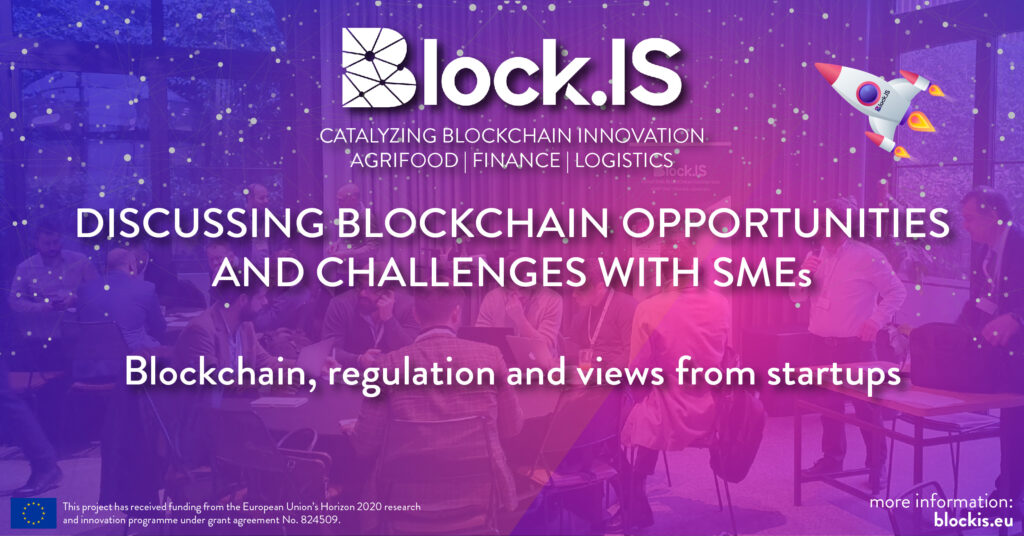
Block.IS was recently involved in a series of webinars in which challenges around policy and regulation around Blockchain were discussed. In one of the webinars the project organised and dubbed Blockchain Policy and Regulatory Challenges, Block.IS startups were specifically addressed by asking:
Given a (slow) shifting policy and regulatory landscape, how can businesses continue to innovate with Blockchain?
This series of two articles will discuss some of the issues that came up in the webinars and discussion points suggesting a way forward. In the first article, we described the regulatory landscape and challenges. In this second article, we will explore the experiences of blockchain SMEs with regulation.
In the webinar, we asked the Block.IS startups how and why they opted for blockchain and what benefit a ledger offers in their sector that other forms of trust cannot. How does blockchain offer a better form of an agreement? We also discussed the timeframe of their solutions and connected to that the sustainability of the ledger.
In Europe, a number of application areas are prevalent. At an earlier webinar, organized by the Digital SME Alliance on blockchain, Marco Bianchini (OECD) presented a study on blockchain application trends, in which supply chain tracking, machines- and IP protection were fore-fronted. Specifically for Europe, we see a strong focus on self-sovereign identity (SSI) as an application area of blockchain. Another application area can be found in Israeli blockchain, in which more back-bone and cybersecurity applications of blockchain were found. These and other examples can be found on the application monitor run by the EU Blockchain Observatory in which more details can be found per EU Member State. In Block.IS, the sectors of interest are finance, logistics, and agriculture. In these spaces, introducing networks of immutable proofs can potentially streamline many processes of authentication and replace paper trails by immediately accessible and shareable proofs. A more efficient process saves time and therefore money. Moreover, it reduces the administrative burden within value chains, and may improve the quality of the chain of regulation for goods and transactions.
However, such benefits are never easily achieved: besides startup costs for many organisations in the value chain having to adopt new technical and organisational ways of working, potentially disruptive ways of creating and securing transactions will also face regulatory challenges in many sectors. No specific regulatory efforts have been made yet to allow blockchain-based transactions or networks of immutable proofs to enter the existing ways of doing. In that regard, more experience and insights are needed as to how the ledger-based systems alter current processes of proving something is what it says it is, or that a process has taken place as stated, and how that affects policy and regulation in these sectors.
The Blockchain Policy and Regulatory Challenges webinar gave an overview of the current state of the art in blockchain technology and discussed the challenges that SMEs face regarding regulation. The relevant regulations that SMEs deal with are the GDPR, eIDAS, KYC/AML requirements (especially in the finance sector) and MiCA. One of the challenges that a participant mentioned is that each regulation has a different approach. This particularly affects SMEs that work cross-border because many countries in the EU have different policy strategies and ways to approach digital asset management. Another challenge identified by the participants, was the low level of understanding across businesses of what blockchain actually is. Many participants agreed that sector-specific companies such as banks or farmers as well as regulators do not have a good understanding of what blockchain is and what it can do. Moreover, it was mentioned that at the moment there is no single market solution, which is experienced as a barrier, since this leaves for a myriad of solutions that each will be in need of a separate legal check.
Creating an ecosystem for innovation with blockchain will require a certain course of action. First of all, more work is needed to show and explain what it does and why it offers potential advantages. This makes blockchain a difficult innovation: you need economists and mathematics to understand the added value, one participant stated. We need to better explain that blockchain is about consensus and transactional power, rather than ‘cutting out the middle man’. This requires new ideas and better support to help companies that are hesitant to step onboard. Some building blocks that can help companies make use of blockchain are an open and controllable EU infrastructure, a clear vision about its added value in the sector, and regulatory clarity both in a general sense and sector-specifically.

